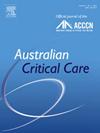用机器学习每8小时预测重症监护病房患者的谵妄:模型开发和评估
IF 2.7
3区 医学
Q2 CRITICAL CARE MEDICINE
引用次数: 0
摘要
目的重症监护病房(ICU)的谵妄与较差的短期和长期预后相关,识别ICU住院期间存在谵妄风险的患者仍然很困难。本研究旨在开发一种基于机器学习的预测模型,用于识别ICU住院期间每8小时发生一次谵妄。方法回顾性收集某单中心混合ICU电子病历资料。2023年1月至2023年12月入住ICU且住院时间超过24小时的成年患者均符合本研究的条件。结果为谵妄,定义为重症监护谵妄筛查检查表得分为4分或以上。使用四种机器学习算法(XGBoost, LightGBM, CatBoost和random forest)使用holdout方法开发预测模型。结果共纳入273例患者,其中谵妄170例(62.3%)。该数据集包括2321份谵妄评估,其中822份(35.4%)谵妄阳性。CatBoost表现出最好的性能;测试数据集的曲线下面积、平均精度和brier评分分别为0.886(95%可信区间[CI]: 0.857-0.909)、0.804 (95% CI: 0.749-0.852)和0.131 (95% CI: 0.115-0.149)。该模型的准确率为0.816,特异性为0.900。精密度为0.775,召回率为0.668。常规收集的护理观察变量,包括重症监护谵妄筛查清单评分和格拉斯哥昏迷量表评分,在预测谵妄方面发挥了重要作用。结论基于机器学习的预测模型在识别谵妄患者风险方面具有一定的潜力。然而,需要进一步研究更大的样本量和更大的患者群体异质性,以指导护理干预。我们的预测模型将使护理专业人员能够仅使用常规收集的变量来识别谵妄高风险患者。护士将能够实施及时的预防护理,优化人员配置和患者的治疗环境,以减少谵妄的危险因素。本文章由计算机程序翻译,如有差异,请以英文原文为准。
Predicting delirium in intensive care unit patients every 8 hours with machine learning: Model development and evaluation
Objectives
Delirium in the intensive care unit (ICU) is associated with poor short- and long-term outcomes, and identifying patients at risk of delirium during ICU stay remains difficult. This study aims to develop a machine learning–based prediction model for identifying delirium occurrence every 8 hours during ICU stay.
Methods
We retrospectively collected data from the electronic medical records in a single-centre mixed ICU. Adult patients who were admitted to the ICU between January 2023 and December 2023 and spent more than 24 h in the ICU were eligible for this study. The outcome was delirium defined as an Intensive Care Delirium Screening Checklist score of 4 or more. Four machine learning algorithms (XGBoost, LightGBM, CatBoost, and random forest) were used to develop prediction models using a holdout method.
Results
273 patients were included in the study, and 170 patients (62.3%) experienced delirium. The dataset consists of 2321 delirium assessments of which 822 (35.4%) were delirium positive. CatBoost demonstrated the best performance; area under the curve, mean precision, and brier score on the test dataset were 0.886 (95% confidence interval [CI]: 0.857–0.909), 0.804 (95% CI: 0.749–0.852), and 0.131 (95% CI: 0.115–0.149), respectively. The model achieved an accuracy of 0.816 and specificity of 0.900. Precision was 0.775 while maintaining recall at 0.668. Routinely collected nursing observational variables, including Intensive Care Delirium Screening Checklist subscores and the Glasgow Coma Scale score, played a significant role in predicting delirium.
Conclusions
Our machine learning–based prediction model demonstrated potential in identifying patients at risk of delirium. However, further research with a larger sample size and greater heterogeneity in the patient population would be needed to guide nursing interventions. Our prediction model would enable nursing professionals to identify patients at high risk of delirium using only routinely collected variables. Nurses would be able to implement timely preventive care and optimise staffing and the patients’ therapeutic environment to reduce risk factors of delirium.
求助全文
通过发布文献求助,成功后即可免费获取论文全文。
去求助
来源期刊

Australian Critical Care
NURSING-NURSING
CiteScore
4.90
自引率
9.10%
发文量
148
审稿时长
>12 weeks
期刊介绍:
Australian Critical Care is the official journal of the Australian College of Critical Care Nurses (ACCCN). It is a bi-monthly peer-reviewed journal, providing clinically relevant research, reviews and articles of interest to the critical care community. Australian Critical Care publishes peer-reviewed scholarly papers that report research findings, research-based reviews, discussion papers and commentaries which are of interest to an international readership of critical care practitioners, educators, administrators and researchers. Interprofessional articles are welcomed.
 求助内容:
求助内容: 应助结果提醒方式:
应助结果提醒方式:


